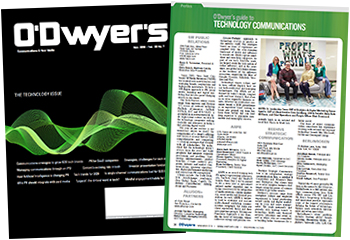 Brian Sinderson Brian Sinderson |
Reaching the right audience with your message can be daunting in a world where more than 188 million emails, 18 million texts and 511,000 tweets get sent every minute.
And those numbers represent just a fraction of the advertising, digital and print content that entices audiences to buy a product or service.
Regardless of whether you’re trying to reach a B2B or B2C audience, people are more distracted by the abundance of messages across multiple channels than ever. Before we can leverage the data and insights that marketers value, people first need to engage with the content communicators disseminate.
 |
| This article is featured in O'Dwyer's Nov. '19 Technology PR Magazine. |
It’s up to savvy PR professionals to connect with audiences through impactful stories that break through the clutter.
As communicators, we have access to a variety of tools to help us understand if our messages are reaching specific audiences to influence buying decisions. The analytics generated help us better understand many of the demographic and psychographic details of our target audiences. When they get translated into specific insights, they can also help us know how and when to reach buyers with the information they need to make informed decisions.
These insights are especially helpful on the B2B front, where corporate technology buyers are often more digitally savvy and self-directed in the way they search for information. According to Forrester, the corporate buyer is more in control of purchasing decisions than ever. Three-quarters of buyers use social media to learn about different vendors, while 68 percent conduct research online to inform purchasing decisions.
More and more, the business buyer wants specific information about the products and services that interest them, so they can understand the benefits and value of what they’re buying.
The focus on customer benefit isn’t a new concept, but it can be challenging to implement across each marketing channel. Communicators are driving more integrated efforts to deliver consistent messages and proof points to customers.
While data and insights provide value in understanding why audiences make purchasing decisions, we can’t lose sight of how we communicate. Although it may change to reflect the times, the sector, the audience, or the channel, compelling storytelling will never go out of style. But, understanding how to capture someone’s attention and hold it long enough to deliver that “aha” moment is an art form that marketers and PR professionals need to continue to embrace and perfect.
It’s also the reason leading-edge technology companies value public relations as a marketing tool to craft stories that get attention, relate to industry news or trends or convey unique customer value.
Because audiences get inundated with multiple content choices, we need to leverage our storytelling craft to engage them at the onset. The elements of good storytelling haven’t changed that much over the years. However, they often are forgotten or not considered, especially in the tech world where speeds and feeds can get in the way of good marketing.
The stories that tech PR pros tell need to be relatable, personable, creative, genuine, visual and authentic. They need to be based on facts and not fake.
Communicators should be curious and do their research to understand the best way to engage the audiences they’re trying to reach. For inspiration, consider TED Talks. The best TED Talks incorporate all the elements of good storytelling to deliver some of the most powerful speeches on topics that drive people to take action. Who can forget Bill Gates’ speech on malaria, where he released mosquitos—not infected—into the audience? He knew how to get their attention, but backed it up with a compelling story based on facts and his personal experience.
Creativity is essential and authenticity is crucial. Companies that oversell themselves run the risk of failure before they’ve even begun. The days of “fake it until you make it” are gone. On the flip side, brands that are too modest may not express the benefits of their new technology, product or service clearly or in a manner compelling enough to get the attention of a buyer.
Also, some companies fail to understand that storylines can become marginalized through a management-by-committee approach that overuses tech jargon and strips out creativity.
Because more business buyers lean on their research to make purchasing decisions, getting the right content in front of buyers is critical. Adding compelling statistics, endorsements from customers, business benefits, and results tell a better story. Incorporating wit and short, snappy prose will get a buyer’s attention and draw them in.
Backing up your claims with factual detail and proof points will help drive engagement.
In today’s world, it’s challenging to convey unique differentiators that get the attention of a business buyer. Stories that help frame the value of a technology product or service are often the most complex and challenging to tell, but when done well, they can engage audiences to take action.
In an age where more products vie for user attention and dollars, conveying the right story can make all the difference, so marketers can get the data and insights they need to drive sales.
***
Brian Sinderson is Senior Partner and East Coast Tech Practice Lead at Finn Partners.


 Laura Anderson, who rose to VP/GM of global communications and events in a nearly 20 year stint at Intel, will take on the Americas technology chair at Burson following the completion of the BCW and H+K merger on July 1.
Laura Anderson, who rose to VP/GM of global communications and events in a nearly 20 year stint at Intel, will take on the Americas technology chair at Burson following the completion of the BCW and H+K merger on July 1. WE Communications has partnered with ROKK Solutions to form the WE ROKK AI service.
WE Communications has partnered with ROKK Solutions to form the WE ROKK AI service. In the dynamic world of modern business, effective communication is a pivotal tool for success across various industries. At Communications Strategy Group (CSG®), our expertise in embracing innovation in communication extends beyond traditional marketing strategies, paving the way for transformative industry-specific solutions.
In the dynamic world of modern business, effective communication is a pivotal tool for success across various industries. At Communications Strategy Group (CSG®), our expertise in embracing innovation in communication extends beyond traditional marketing strategies, paving the way for transformative industry-specific solutions. There are two types of tech PR professionals. Which one are you? And are C-suite executives making that decision for you?
There are two types of tech PR professionals. Which one are you? And are C-suite executives making that decision for you? While there’s an impulse to grab reporters’ attention with the newest industry-transforming tech product or service, a back-to-basics approach focused on telling the right stories to the right people is a far more successful way to ensure your technology campaign breaks through the clutter of today’s crowded tech landscape.
While there’s an impulse to grab reporters’ attention with the newest industry-transforming tech product or service, a back-to-basics approach focused on telling the right stories to the right people is a far more successful way to ensure your technology campaign breaks through the clutter of today’s crowded tech landscape.


 Have a comment? Send it to
Have a comment? Send it to 
No comments have been submitted for this story yet.